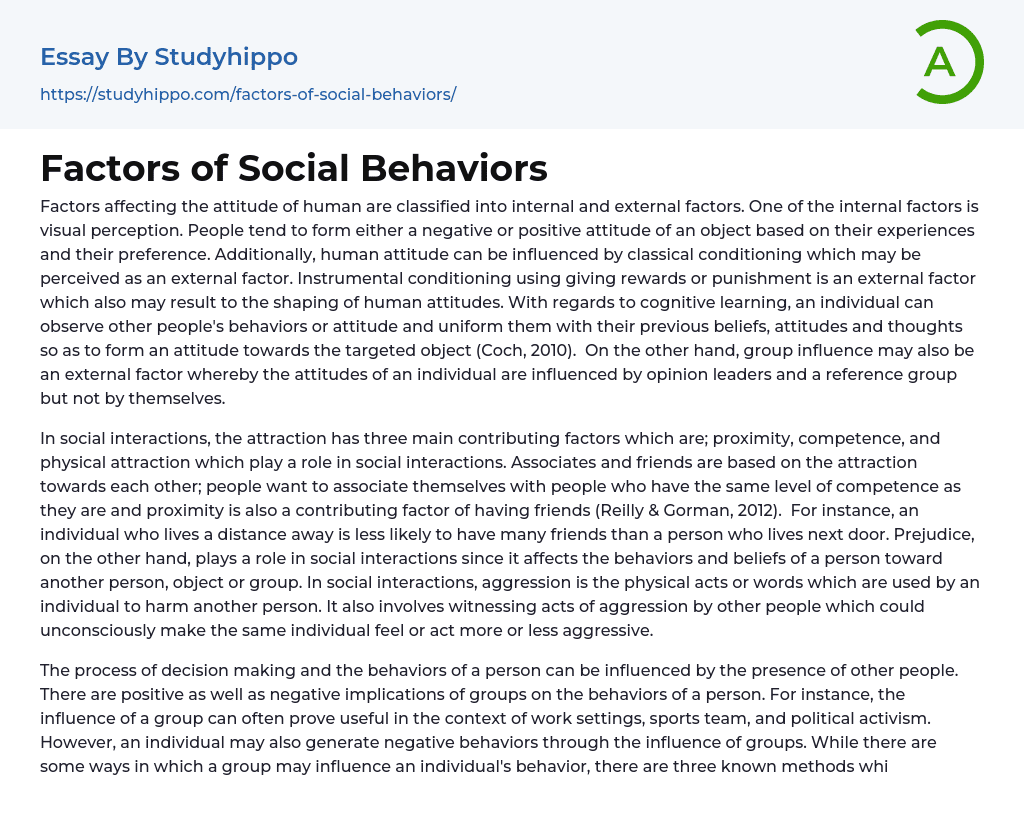Factors affecting the attitude of human are classified into internal and external factors. One of the internal factors is visual perception. People tend to form either a negative or positive attitude of an object based on their experiences and their preference. Additionally, human attitude can be influenced by classical conditioning which may be perceived as an external factor. Instrumental conditioning using giving rewards or punishment is an external factor which also may result to the shaping of human attitudes. With regards to cognitive learning, an individual can observe other people's behaviors or attitude and uniform them with their previous beliefs, attitudes and thoughts so as to form an attitude towards the targeted object (Coch, 2010). On the other hand, group influence may also be an external factor whereby the attitudes of an individual are influen
...ced by opinion leaders and a reference group but not by themselves.
In social interactions, the attraction has three main contributing factors which are; proximity, competence, and physical attraction which play a role in social interactions. Associates and friends are based on the attraction towards each other; people want to associate themselves with people who have the same level of competence as they are and proximity is also a contributing factor of having friends (Reilly & Gorman, 2012). For instance, an individual who lives a distance away is less likely to have many friends than a person who lives next door. Prejudice, on the other hand, plays a role in social interactions since it affects the behaviors and beliefs of a person toward another person, object or group. In social interactions, aggression is the physical acts or words which are used b
an individual to harm another person. It also involves witnessing acts of aggression by other people which could unconsciously make the same individual feel or act more or less aggressive.
The process of decision making and the behaviors of a person can be influenced by the presence of other people. There are positive as well as negative implications of groups on the behaviors of a person. For instance, the influence of a group can often prove useful in the context of work settings, sports team, and political activism. However, an individual may also generate negative behaviors through the influence of groups. While there are some ways in which a group may influence an individual's behavior, there are three known methods which include; group shift, groupthink, and de-individuation. First, group shift occurs when the original positions of members in a group become more exaggerated towards a position which is more extreme. Secondly, groupthink occurs when the members in a group encounter an important choice hence become attentive towards making a rapid and smooth decision that they overlook other options which are possibly more fruitful.
Obedience occurs when an individual acts under the authority of another leader figure. Parental relationships, military units, workplace hierarchies and school settings are among the various examples of how people in authority use obedience for tasks to be accomplished (Litton, 2016). Obedience is more planned, and it is comprised of rules and subordinates. Conformity, on the other hand, occurs when the beliefs and perceptions of an individual are changed because of the norms of a certain group (Chaney, 2013). It occurs when a person simply follows what is being done or said by their
peer group regardless of their previous individual beliefs. However, in a conformist group, no one is told how to behave; the trait only emerges from the desire to be accepted by the group peers or to avoid appearing foolish.
Social psychology can play various roles within a workplace to increase the happiness and satisfaction of workers and employers in a work environment. Since people half of the day, while working, many leaders and organizations are on the rise of acknowledging that using psychological methods and knowledge in a work environment is crucial. Employers can use psychology to create engagement, positivity, meaning and connection to create a workforce that is motivated and inspired and which is not only excited about being at work but excited about making contributions to the company as well.
References
- Coch, D. (2010). Human behavior, learning, and the developing brain: Atypical development. New York: Guilford.
- Reilly, N. P., Sirgy, M. J., & Gorman, C. A. (2012). Work and quality of life: Ethical practices in organizations. Dordrecht: Springer Netherlands.
- Chaney, D. W. (2013). An Overview of the First Use of the Terms Cognition and Behavior. Behavioral Sciences (2076-328X), 3(1), 143-153. doi:10.3390/bs3010143
- Litton, E. (2016). Harnessing Unobservable Diversity. OD Practitioner, 48(1), 39-44.
- Abnormal Psychology essays
- Abraham Maslow essays
- Attachment Theory essays
- Authority essays
- Behaviorism essays
- Classical Conditioning essays
- Cognitive Psychology essays
- Counseling essays
- Developmental Psychology essays
- Educational Psychology essays
- Erik Erikson essays
- Family Therapy essays
- Jean Piaget essays
- Maslow's Hierarchy Of Needs essays
- Mental Health essays
- Operant Conditioning essays
- Personality Psychology essays
- Positive Psychology essays
- Psychoanalysis essays
- Psychotherapy essays
- Sigmund Freud essays
- Social Psychology essays
- Stanford Prison Experiment essays
- Supersize Me essays
- Positive Attitude essays
- Caste System essays
- Citizenship essays
- Civil Society essays
- Community essays
- Culture essays
- Deviance essays
- Discourse Community essays
- Female essays
- Filipino People essays
- Igbo People essays
- Indigenous Australians essays
- Indigenous Peoples essays
- Men essays
- Middle Class essays
- Minority Group essays
- Modern Society essays
- Popularity essays
- Social Control essays
- Social Institution essays
- Social Justice essays
- Social Norms essays
- Social Responsibility essays
- Socialization essays
- The nation essays




